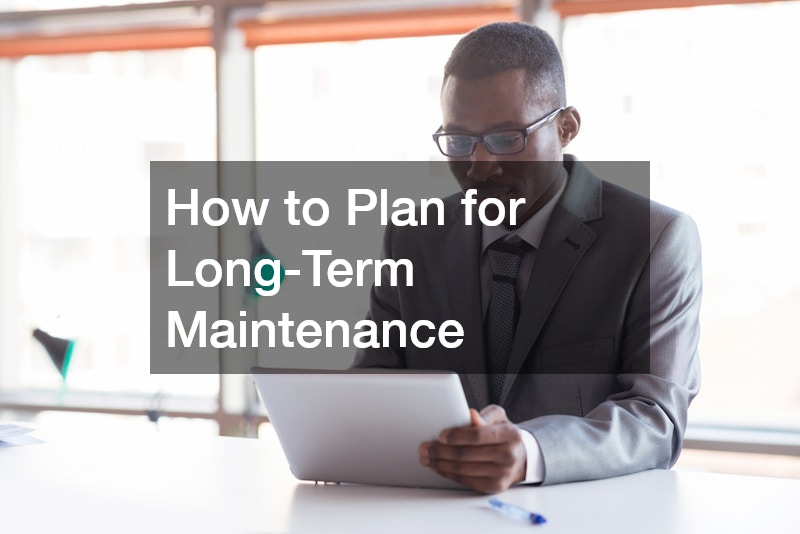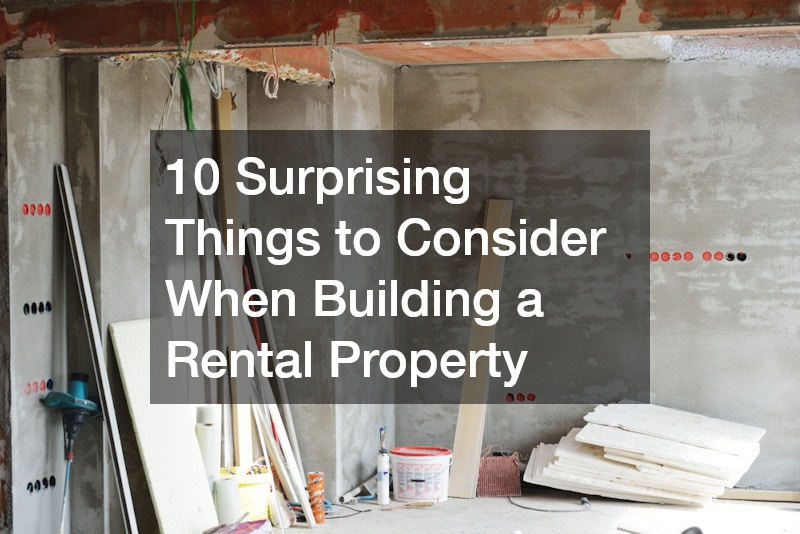Building a rental property can be one of the most rewarding investments you undertake, offering steady cash flow and long-term wealth-building opportunities. However, there’s more to the process than purchasing land and erecting a structure. Many critical details—some of which may not immediately come to mind—play a significant role in determining the success of your investment. In this article, we’ll dive into ten surprising considerations to keep in mind when building a rental property, ensuring you cover every base for a profitable and appealing rental.
What Are the Initial Costs Involved in Building a Rental Property?
Land Acquisition
The first step in building a rental property is securing the land. While some investors focus solely on price, location and zoning regulations are just as crucial. Assess the neighborhood and confirm that your plans comply with local zoning laws. Additionally, factor in any preparation work the land may require, such as tree removal or grading, as these can add significant costs.
Planning and Permits
Obtaining permits and developing a plan are vital steps that can add to your upfront costs. You’ll need permits for construction, plumbing service installation, and electrical work. Hiring experts familiar with your municipality’s requirements can streamline the process and help avoid costly delays.
Excavating the Property
Before construction begins, excavation services are often required to prepare the land. This includes clearing debris, leveling the site, and digging for foundations. Excavation costs can vary significantly depending on soil conditions, site size, and access.
Construction Expenses
Construction costs include everything from hiring a construction contractor to purchasing materials for home construction. Depending on the design and materials chosen, these expenses can escalate quickly. Make sure to budget for high-quality components that will attract tenants and reduce maintenance costs in the long run.
Financing Costs
Financing your project often comes with hidden fees, such as loan origination fees, interest payments, and closing costs. Ensure you account for these expenses when calculating your budget for building a rental property.
Unexpected Fees
Additional costs often arise unexpectedly, including fees for permits, environmental inspections, or foundation waterproofing to prevent future water damage. Setting aside a contingency fund can help you manage these surprises without derailing your timeline.
How to Choose the Right Location for a Rental Property

Neighborhood Research
When selecting a location, thoroughly research the neighborhood. Look for areas with growing populations, a demand for rentals, and low vacancy rates. A construction contractor can often provide insights into trends in local property development and where future rental demand may grow.
Proximity to Amenities
Tenants are drawn to properties near schools, grocery stores, parks, and public transportation. Proximity to these conveniences can justify higher rental rates and keep your property competitive in the market.
Future Development Plans
Investigate future development in the area. Projects such as new shopping centers, business parks, or transport upgrades can significantly boost property values and rental demand.
Crime Rate Statistics
Safety is a top concern for tenants. Research local crime statistics and consider installing security features if the area has a moderate crime rate.
Accessibility and Transport Options
Easy access to highways, public transportation, and bike-friendly infrastructure will appeal to a wide range of tenants, including professionals and families.
What Design Features Attract Tenants?
Design plays a significant role in attracting tenants to your rental property. The right choices can make your property more appealing, justify higher rental rates, and reduce vacancy periods. Let’s explore some design features that are particularly attractive to modern renters.
Open Floor Concepts
Open floor plans are highly sought after by tenants who value versatility and space optimization. Removing unnecessary walls between common areas like the kitchen, dining, and living rooms creates a sense of spaciousness and improves the flow of natural light. This design also appeals to tenants who enjoy entertaining, as it fosters better interaction between spaces. While implementing this feature may add to construction costs, the increased tenant interest and rental income potential often make it worth the investment.
Additionally, open floor plans allow renters to customize their living spaces to suit their preferences. Whether they need room for a home office or a play area for children, this flexibility makes your property more adaptable to various tenant demographics, increasing its market appeal.
Flooring
Flooring is more than just an aesthetic choice—it’s a practical consideration that can impact maintenance costs and tenant satisfaction. Hardwood floors are a timeless option that adds elegance and durability, but they can be expensive to install and maintain. High-quality vinyl or laminate flooring, on the other hand, offers a cost-effective alternative that mimics the look of wood while providing excellent durability and water resistance.
Modern Kitchen and Bathrooms
The kitchen and bathrooms are often the first areas prospective tenants evaluate when touring a property. Modernizing these spaces can significantly boost your property’s appeal. In the kitchen, prioritize energy-efficient appliances, ample counter space, and smart storage solutions such as pull-out shelves or vertical cabinets. Tenants appreciate functionality, so consider features like large sinks, built-in microwaves, and islands with additional seating.
Energy Efficiency
Today’s tenants are increasingly conscious of energy efficiency, both for its environmental impact and cost-saving potential. Installing energy-efficient windows, appliances, and LED lighting can make your property stand out. Proper insulation and advanced HVAC systems can further reduce utility costs, benefiting both you and your tenants. Consider installing a programmable or smart thermostat, which allows tenants to manage energy consumption conveniently.
Smart Home Technology
Incorporating smart home technology can be a game-changer for your rental property. Features such as smart locks, video doorbells, and app-controlled lighting systems offer tenants convenience and peace of mind. These technologies are particularly appealing to tech-savvy renters and younger demographics who value innovation.
Smart thermostats and energy monitoring systems can also reduce utility costs, making your property more affordable and attractive. Additionally, consider offering pre-installed internet service with high-speed connections, as this is a top priority for many tenants, especially remote workers or students.
Outdoor Spaces
Outdoor spaces are a highly valued amenity for renters, especially those with families or pets. Whether it’s a small balcony, a patio, or a fully landscaped backyard, outdoor areas provide tenants with additional living space and a place to relax or entertain.
If space allows, consider adding features such as a fire pit, outdoor seating, or even a garden area. For properties in urban settings, rooftop terraces can be a unique selling point, offering tenants a retreat with a view. Outdoor amenities not only enhance tenant satisfaction but also increase the perceived value of your property, allowing you to charge higher rents.
How to Plan for Long-Term Maintenance

Durable Materials
Selecting durable materials for walls, floors, and fixtures can significantly reduce the need for repairs over time. Quality pays for itself in lower maintenance costs and tenant satisfaction.
Roofing
Ensure the roof is installed by a reputable roof contractor and made with long-lasting materials. A sturdy roof is essential for protecting your investment and avoiding costly water damage.
Regular Inspections
Schedule regular property inspections to catch potential problems early. Inspect key systems like plumbing, HVAC, and the roof annually or biannually.
Maintenance Contracts
For systems like HVAC, plumbing, and pest control, consider purchasing maintenance contracts. This ensures timely servicing and minimizes emergency repair costs.
Emergency Repair Fund
Unexpected issues are inevitable. Setting aside an emergency repair fund can cover urgent repairs like a broken water heater or HVAC failure without straining your finances.
What Are the Legal Considerations?
Local Building Codes
Compliance with local building codes is essential. This includes everything from electrical wiring to foundation waterproofing. A violation can lead to hefty fines or legal challenges, so work closely with your construction contractor to ensure compliance.
Landlord-Tenant Laws
Understanding local landlord-tenant laws is crucial. These govern everything from security deposits to eviction procedures and protect both you and your tenants.
Lease Agreements
Craft comprehensive lease agreements that outline terms clearly to avoid disputes. Consulting a legal expert can ensure your lease complies with local laws and protects your interests.
Insurance Requirements
Rental properties require specific insurance policies, such as landlord insurance. This typically covers property damage, liability claims, and lost rental income.
Fair Housing Compliance
Adhering to fair housing laws ensures you avoid legal complications related to discrimination claims. Train any staff involved in property management to follow these guidelines.
How Do I Set the Right Rental Price?
Market Analysis
Conduct a thorough market analysis to understand rental trends in your area. Research comparable properties to gauge what tenants are willing to pay.
Comparable Properties
Compare your property to similar rentals in terms of size, location, and amenities. This ensures you set a competitive yet profitable price.
Cost of Ownership
Factor in all ownership costs, including taxes, insurance, and maintenance, when determining your rental price.
Rental Yield Goals
Establish rental yield goals to ensure your investment is financially sustainable. Aim for a balance between profitability and affordability to attract tenants.
Adjustment for Seasonality
The rental market fluctuates with the seasons. Be prepared to adjust your pricing or offer promotions during slow periods.
Should I Hire a Property Manager?

Pros of Professional Management
A property manager can handle tasks such as tenant screening, rent collection, and maintenance requests, saving you time and stress.
Cons to Consider
The downside is the cost—property management fees typically range from 8-12% of your rental income.
Cost of Services
Weigh the cost of hiring a manager against the value of your time and the level of service they provide.
DIY Management Techniques
If you choose to manage the property yourself, invest in tools like online rent collection platforms and maintenance tracking systems to simplify the process.
Time Commitment Evaluation
Managing a rental property requires time and effort. Be realistic about your availability before deciding to go the DIY route.
What Are the Tax Implications?
Property Taxes
Understand the property tax rates in your area and incorporate these into your budgeting and rental pricing.
Depreciation Benefits
Rental properties are eligible for depreciation, which can significantly reduce your taxable income.
Tax Deductions for Expenses
Many expenses, including repairs, property management fees, and even excavation services, are tax-deductible. Keep detailed records to maximize your deductions.
Capital Gains Tax
When selling a rental property, you may be subject to capital gains tax. Familiarize yourself with strategies to minimize this cost.
Record-Keeping Requirements
Accurate record-keeping is essential for tax compliance and financial planning. Invest in software to track income and expenses efficiently, such as hiring on an electrician to do work.
How Can Technology Improve Property Management?
Online Rent Collection
Online rent collection systems make payments more convenient for tenants and ensure timely deposits for landlords.
Tenant Screening Tools
Use tenant screening tools to identify reliable tenants. These systems can verify income, credit scores, and rental histories.
Maintenance Tracking Systems
Tracking maintenance requests and repairs digitally ensures issues are resolved promptly, boosting tenant satisfaction.
Communication Platforms
Streamline communication with tenants through platforms that allow for easy messaging, updates, and notifications.
Smart Security Systems
Smart security systems can enhance tenant safety and property value. Features like video doorbells and alarm systems are particularly appealing.
How to Ensure Tenant Satisfaction

Effective Communication
Maintaining open and clear communication with tenants fosters trust and reduces misunderstandings.
Responsive Maintenance
Quickly addressing maintenance issues—especially HVAC problems that would require an HVAC contractor—is one of the most effective ways to keep tenants satisfied.
Community Building Activities
Organize community-building activities, like barbecues or tenant appreciation events, to foster a sense of belonging.
Providing Amenities
Offering amenities such as laundry facilities or parking can greatly enhance tenant satisfaction and retention.
Regular Feedback and Surveys
Conduct regular tenant surveys to identify areas for improvement and show that you value their input.
Building a rental property is a multifaceted endeavor that goes beyond laying bricks and mortar. From planning for excavation services to ensuring tenant satisfaction, each step plays a critical role in the long-term success of your investment. By considering these ten often-overlooked aspects, you can create a rental property that attracts tenants, reduces costs, and generates consistent returns. Remember, attention to detail and strategic planning are the keys to turning your vision into a profitable reality.

